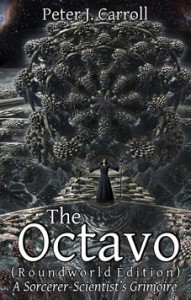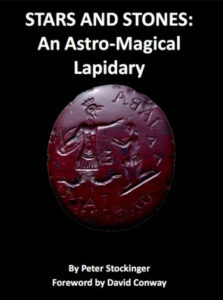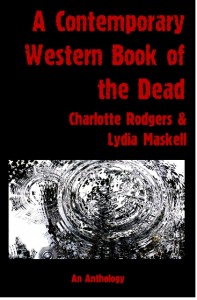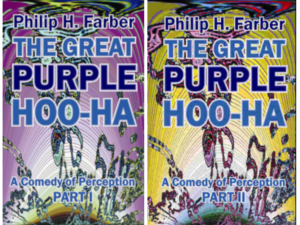A Sorcerer-Scientist’s Grimoire
Peter J. Carroll

The Octavo
A Sorcerer-Scientist’s Grimoire
Peter J. Carroll
Format: Softcover
ISBN: 9781906958176
£15.00 / US$24.00
Subjects: Chaos Magick
Click HERE for The Octavo / USA
Click HERE for The Octavo / UK
Click here for Kindle UK Edition
Click here for Kindle USA Edition
Every universe potentially has its own Supreme Grimoire containing the spells which define its reality and the magic which you can perform within that reality. In this Octavo we have assembled scattered secrets for a Supreme Grimoire for Roundworld, the universe in which you’re standing.
To this end we have taken some inspiration from Pratchett’s Discworld, and a lot from Theoretical Physics and Practical Chaos Magic.
The most original, and probably the most important, writer on Magick since Aleister Crowley.”
– Robert Anton Wilson. Author of the Cosmic Trigger trilogy.
Review of The Octavo by Dave Lee
This is the second book Pete Carroll has brought out in the last two years, after a number of years’ silence. In 2008, there was ‘The Apophenion’, which was something of a departure towards an overall philosophical position, which we might call chaoism, as distinct from chaos magic. Now he presents us with a new synthesis that aims at a much closer marriage of scientific theory and magic than he, or, to my knowledge, anyone else, has attempted.
The first thing you’ll notice about this book (other than the excellent illustrations) is the subtitle. The reference will be lost on non-Pratchett experts like me; I’ve enjoyed a few of Pratchett’s books and found others a bit twee for my taste. (I have to admit, though, that he shows superb understanding of the thermodynamics of godhood in ‘Small Gods’, and a brilliant vision of the Other in ‘Lords and Ladies.’) Apparently, there’s an Octavo of Discworld spells, and it seems this volume is using the conceit that it’s the Roundworld equivalent in order to show how physics and magic can be combined in two very different universes.
The second thing you’ll notice is the physics. Publishers say that every equation in a book halves the readership, and there are a lot of them in The Octavo*. More, in fact, than in Liber Kaos, but they – at least the ones in the first few chapters – are of a very different kind.
The ‘Equations of Magic’ in Liber Kaos have always been problematic: they dealt in quantities which are not measurable, and probably never will be, like ‘degree of gnosis’ and ‘magical link’. So, they are not really equations, but things that look like equations; what they amount to, at best, is a mental checklist, a summary of what we know about magic so far. With a shorthand like that, all that matters is that it’s easily memorable, and the physico-mathematical symbolism does not help at all.
The equations in Octavo are very different. They are much more ambitious, genuinely cosmogonic in nature, and I suspect they have some very important things to say – to those who understand them rather more deeply than I do. I did get lost for much of chapters 2 and 3 (I only have maths to just short of A-level), but surfaced again at the start of Ch 4, where he compares Discworld and Roundworld physics, and comes out with some pretty profound stuff.
One of the things that’s particularly interesting about Carroll’s science is the way he attributes real physical – or aetheric / shadow-physical – reality to quantities that appear in the fundamental equations of physics. In Liber Kaos for instance the wavefunction in the Schroedinger equation is a measure of a real quantity in shadow-time, rather than a mere mathematical convenience, to be discarded as soon as possible in the course of calculations. No, Carroll finds a home for these misty, despised quantities, integrating them into a description of a magical universe. In The Octavo, he comments about quantum superposition, which is a concept we’re normally just supposed to get our heads round, that it actually has fine detail which makes it much more physically real – the alternative forms of the particle are kind of parked in sideways-time. For me, that is a distinct improvement on the usual way superposition is described.
This realistic use of mathematical entities recalls Galen Strawson’s ‘real materialism’**, as does this (p97):
‘A visualized or imagined event can have a similar effect on the imaginary time plane as the probability function of a material event, because it too constitutes a wave-particle event’.
In other words, ‘thoughts are as real as rocks’, to the real, Strawsonian materialist. Carroll also gives a physico-mathematical reality to Sheldrake’s morphogenetic fields – they are the information contained in the virtual radiations emitted by everything all the time.
I do like the depiction of particles as closed universes (p23), and it’s satisfying to read Theories of Everything, but the problem for the mathematically sub-literate becomes: how can I distinguish the true ones? I’m not sure that Carroll’s doing away with the Big Bang (a dirty job, but someone had to do it) yields a truly more complete ToE than the current one: a steady state model of the universe comes no closer to explaining where everything comes from than the expanding-from-a-point one does, it simply makes it an unaskable question, which is not the same thing. His cosmological explanation of the red shift (the core mystery of cosmology) involves something like a new mechanism for Zwicky’s previously-rejected ‘tired light’ hypothesis, and I have asked a mathematical friend of mine how viable an explanation it is.
Some of my reservations about this book stem from Carroll’s over-willingness to form Laws. Right near the beginning of the book, he has concreted the ‘multiple selves’ model into one. The idea of selfhood as multiple arose out of a very postmodern milieu of thought about what we are, and has proved very useful to magicians. However, it does suffer from a vagueness at its core: it would be a good idea to clarify the difference between personalities and the moment-to-moment sense of selfhood. The former may be usefully thought of as multiple, but the sense of self is always and ever phenomenologically singular. I challenge anyone to describe how it can be sensed otherwise.
This excessive taste for laws surfaces again on p66, where Carroll attempts to prove that there is always ‘ an even number of selves’, with an argument I found so unconvincing I suspect the author is self-consciously preaching to the choir, knowing we’ll indulge him.
My main criticism of the book is that the ‘Equations of Magic’ reappear in Ch6. I’ve said above why they are not equations, but simply tally-sticks; they remind me of Frazer’s useless laws of magic, but with added algebra to put more people off. Has a magician ever told you they’ve helped him or her plan a working?
Their inclusion wouldn’t be such a bad thing if it wasn’t for the very high quality of arguments pursued using real equations in the cosmological parts of the book: to someone who hasn’t been following the maths very closely but can see how the EoMs cannot be real equations, they simply serve to cheapen the value of the other equations and arouse suspicion about their validity. And to use them to derive, via a complicated chain of reasoning, the conclusion that group magic is no more powerful than individual magic is pure tautology, because the only way anyone could get that conclusion would be by building it into the ‘Equation’ in question.
By the way, can we have a straw poll on this? My feeling is that group magic is immensely more effective for some kinds of enchantment.
The final complaint I have is a purely aesthetic one. Sure, it wouldn’t be a bad idea to replace the phrase ‘material base’ with something else, because we do talk about servitors quite a lot. But the term ‘groundsleve’, to my ear, is down in the flooded and odious basement of English, along with ‘staycation’ and ‘bromance’. (OK, I suppose that means I’ll have to come up with one myself.)
Back to a few final words of praise: One of the satisfying things about this book is the way Carroll fills out and brings up to date old ideas, some of which he has developed and used years before. Like the way the good old GPR gets completed into the GCR, a much more symbolically satisfying and complete thing.
Proper weight is given to the Apocalypse, and what wizards can do to help avert the collapse our stupidity has got us into.
I have to make a special mention of the llustrations. If there was an award for ‘best occult book graphics of the year’, then Matt Kaybrin’s would sweep it, with these bold, dark, unusual mixtures of traditional and cyber-art.
In the end, I would definitely recommend this book. It is important, maybe very important, and will stir some interesting thoughts even in the non-mathematically-inclined. Carroll’s basic attitude to mysteries is the only healthy one: not to try and banish them, like the Dawkinsian parascience bunch, or use them to obfuscate, like the religious do. He writes: ‘Mysteries should present challenges, not opportunities for dumb belief.’
*I showed the book to a mentally tough shaman I know, and as soon as he saw the equations, he declared he’d rather chew his leg off than try to understand them.
‘The Octavo is remarkable in the finest sense of the word: a great and indeed unique achievement, making a genuine physics of magic’.
– Professor Ronald Hutton




